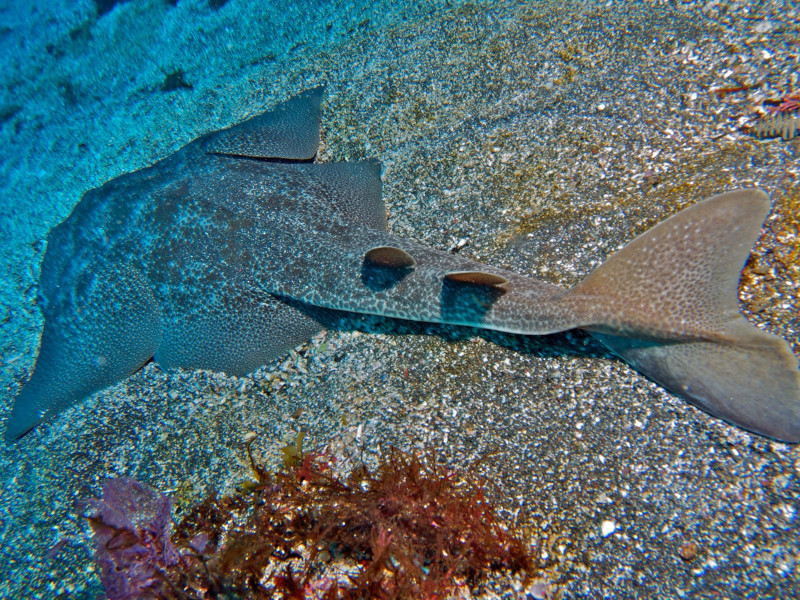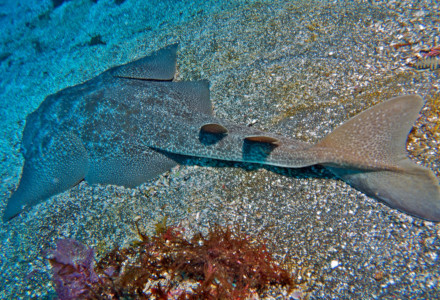
Japanese Angelshark Facts
- Most notably, the fascinating Japanese Angleshark represents a particular species of angelshark with a very specific habitat range. Though of a moderate size, it rarely forms a danger to humans. That’s because it rarely becomes aggressive to humans unless provoked.
- Further, the Dutch ichthyologist Pieter Bleeker first described this animal as a separate species in 1858. Evidence indicates that the species developed around 100 million years ago. However, like many creatures, it now finds itself facing the danger of potential extinction.
- This holds true due to the fact that the actions of humans significantly reduced the population of the once plentiful animal. It remains a popular target for both private and commercial fishing. Commercial fishermen catch it both for its meat and as a source of a leather-like material known as shagreen.
- Because of this ongoing activity, along with its reduced numbers, the IUCN now lists it as Vulnerable. However, it also faces other serious threats to its continued existence. Combined with its reduced population, climate change and habitat loss now leave its continued survival in doubt.
Related Articles
Japanese Angelshark Physical Description
First of all, the remarkable and fascinating Japanese Angelshark represents a moderate to small variety of shark. Also, like the majority of related species, this awesome creature displays no noticeable degree of sexual dimorphism.
Additionally, mature individuals attain radically different maximum lengths. That’s because studied adults range in overall size from 4.9 – 8.2 ft (1.5 – 2.5 m). Also, as can easily be seen, the creature has a highly flattened body shape.
Its upper surface displays various shades of brown, running from light to dark. It also has a thick pattern of roughly square-shaped dark spots. These gradually become smaller as they approach the outside edges of the upper body. Meanwhile, the lower surface of the animal is white with dark blotches.
It also has several very distinctive features. Firstly, both its pectoral and pelvic fins develop as greatly enlarged. Secondly, the widely spaced eyes have a distinctly oval shape. Finally, this amazing creature has a full 10 rows of teeth in its highly widened mouth.
- Kingdom: Animalia
- Phylum: Chordata
- Class: Chondrichthyes
- Order: Squatiniformes
- Family: Squatinidae
- Genus: Squatina
- Species: S. japonica
Japanese Angelshark Distribution, Habitat, and Ecology
As its common name suggests, the fabulous Japanese Angelshark appears in the waters around Japan, in Asia. However, its endemic range actually includes part of the northern Pacific Ocean. This extends from Japan to Taiwan. That range includes the Yellow Sea, the Sea of Japan, the Taiwan Strait, and the East China Sea.
Furthermore, this fascinating fish typically prefers to inhabit portions of the continental shelf. As a result, this bottom-dweller commonly inhabits sandy areas, at depths rarely exceeding 980 ft (299 m). It also likes to inhabit areas of coral reef, when available.
The Japanese Angelshark evolved primarily as an ambush predator. Therefore, it typically spends the majority of the daylight hours mostly buried on the ocean floor, awaiting an opportunity. However, at night, it becomes more aggressive, and actively hunts its prey. These consist mostly of various small cephalopods, fish, and crustaceans.
In addition, like other related species, it developed as a viviparous creature, giving birth to live young. Born in either the spring or summer, a typical litter consists of 2 – 10 individuals. At birth, infants average roughly 8.7 in (22 cm) in length.
Species Sharing Its Range
Check out our other articles on 7 Outstanding Flightless Birds of the World, Golden Armadillo Lizard, Eye of the Sahara, Coast Coral Tree, Ohlone Tiger Beetle, Snowshoe Hare

